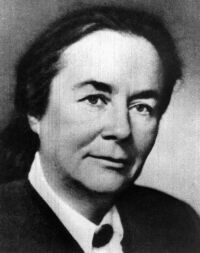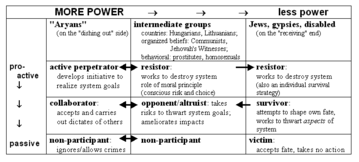Zofia Kossak-Szczucka
and the Protest (back to top)
Zofia Kossak was born into a Polish
Catholic family in 1890. Most of her career was spent as a writer, where
she wrote mainly for the Catholic press. Later in 1936, she received the
Golden Laurel Award from the Polish Academy of Literature. During the
war years, she went underground and began writing for underground newspapers
under the code-name "Weronika" (Tomaszewski and Werbowski, 43).
Later in 1941, she co-founded the Catholic lay organisation known as Front
Odrodzenia Polski (Front for Reborn Poland) and became editor of its
newspaper, Prawda (The Truth). Before her involvement in Zegota,
she was also extensively involved in assisting Jews on an individual level.
In the summer of 1942, when the liquidation of the Warsaw
Ghetto (wikipedia)
began, Kossak published a leaflet entitled "Protest," and printed it in
5,000 copies (Tomaszewski and Werbowski, 43). In the leaflet she described
in graphic details the living conditions in the Warsaw Ghetto and made
known the deportations that were taking place, describing how the world
remained silent in the face of such atrocities. By appealing to both religious
and nationalistic sentiments, she urged the Polish people to actively
oppose and resist such brutalities inflicted on the Jews by the Nazi Germans.
Her call to action through the Protest thus became Zegota’s principal
inspiration.
Front of National Rebirth of Poland
(extracted from "Protest of Zofia Kossak Szczucka",
http://en.wikisource.org/wiki/Protest_of_Zofia_Kossak-Szczucka
). (Accessed 15 November 2005)
PROTEST REMONSTRANCE
In the Warsaw Ghetto,
behind walls separating from the external world, several hundred thousand
convicts are awaiting death. There is no hope for any rescue, help comes
from nowhere. Streets are patrolled by executioners, which fire at anyone
who dares to go out of his house. They also fire at all who show in
windows. On pavements besmear unburied human corpses.
Daily shipments as ordered by the authorities are set
at 8-10 thousand of victims. Jewish policemen are ordered to deliver them
to the hands of German executioners. If they fail, they will be killed.
Children unable to walk themselves are loaded on wagons. The loading process
is so cruel, that only a small number of them reaches the railway platform
alive. Mothers looking at it go insane. The number of the insane from
despair and horror equals the number of the shot-down.
There are railcars waiting at the platform. The executioners
are forcibly packing over 150 convicts in each one. Thick layers of lime
and chlorine are put on the floor of railcars and splashed with water.
The doors of the railcar are being permanently bolted. Trains sometimes
start immediately after the load, however sometimes wait one or two days
on the side rail... It doesn't mean anything. From the people packed so
densely that the dead cannot fall down and are standing arm to arm with
the living, from the people dying of the lime and chlorine gases, without
air, a drop of water, without food - nobody will survive. These death-trains,
whenever and wherever they will arrive they will bring only dead human
corpses.
Confronted with such suffering, quick death seems to
be an answer. The executioners have foreseen it. All the drugstores in
the ghetto have been closed, to avoid supplying with a poison. There are
no guns. The only solution is to jump down out of the window to the street.
Therefore a lot of convicts choose to "escape" their executioners in this
way.
The same that is happening in the Warsaw Ghetto, has
been happening for half a year in hundreds of smaller or larger Polish
towns and cities. The total number of murdered has already exceeded one
million and the number grows each day. All perish. Poor and rich, old,
women, men, youngsters, infants, Catholics dying with the name of Jesus
and Mary together with Jews. Their only guilt is that they were born to
the Jewish nation condemned to extermination by Hitler.
The world is looking at these atrocities, the most horrible
throughout the whole history of mankind, and is silent. Slaughter of the
millions of people is happening in ominous silence. The executioners are
silent, they do not boast with what they are doing. England is silent,
so is America, even the international Jewry is silent, before so sensitive
to all harm to their people. Silent are Poles. Polish political friends
of Jews limit themselves to journalistic notes, Polish opponents of Jews
show no interest in a matter that is alien to them. Dying Jews are surrounded
only by Pilates washing their hands. Silence shouldn't be tolerated anymore.
If for no other reason -- it is mean. Those who are silent in the face
of murder - become partners of the killer. Those who do not condemn -
approve.
We Catholic Poles, form our voice. Our feelings toward
Jews have not changed. We do not stop thinking about them as political,
economic and ideological enemies of Poland. Moreover we do realize, that
they still hate us more than Germans, that they make us co-responsible
for their misfortune. Why? On which basis? It remains the secret of the
Jewish soul. Nevertheless, that is a fact that is continuously confirmed.
Awareness of those feelings, doesn't relieve us from the duty to condemn
the crime.
We don't want to be Pilates. We have no power to actively
prevent German murders, we cannot help, we cannot save anyone, but we
protest from the bottom of our hearts overwhelmed with mercy, fury and
horror. We are required by God to protest. God who forbids us to kill.
We are required by out Christian consciousness. Every human being has
the right to be loved by his fellowmen. Blood of the defenseless cries
to heaven for revenge. Those who oppose our protest - are not Catholics.
Being Polish, we also protest. We do not believe that
Poland can benefit from German cruelties. On the contrary. The continuing
silence of the international Jewry, the German propaganda that tries,
even now, to put the blame for the slaughter of Jews on Lithuanians and...
Poles, we sense a plot of the enemy against us. We also know how poisoned
is the fruit of the crime. The role of forced observer in the bloody spectacle
taking place on the Polish soil, might promote immunity to pain and suffering
and what is the most important, conviction that to murder your neighbour
without any punishment is permisssible. Those who do not understand it
and want to connect the proud and free future of Poland, with contentment
of grief of fellowmen, is neither a Catholic nor a Pole. |

